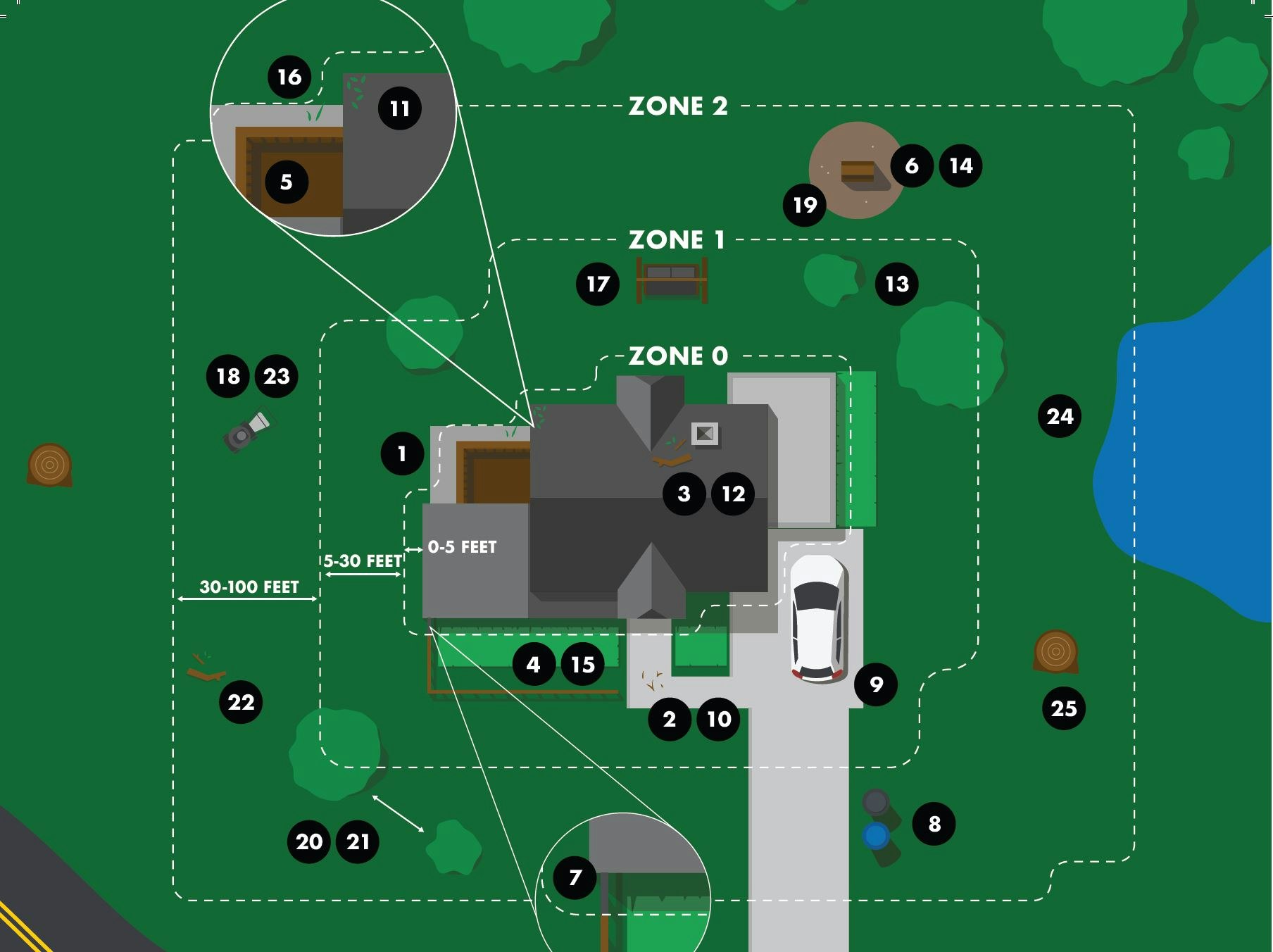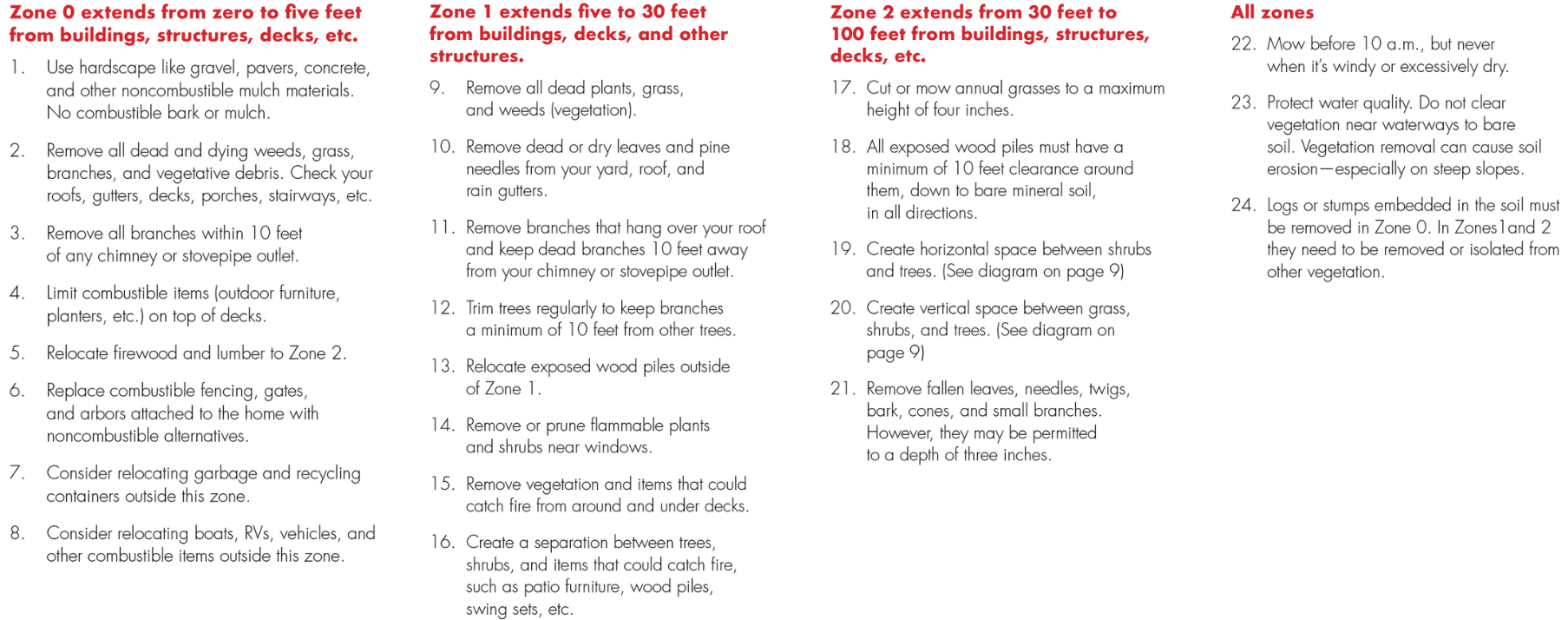Defensible Space Assistance Program
As part of the RCDTC's work to strengthen community wildfire preparedness, the TinderSmart Tehama Defensible Space Assistance Program offers no-cost defensible space assistance to residents within Tehama County's State Responsibility Area (SRA), Local Responsibility Area (LRA), and Wildland-Urban Interface (WUI) zones.
The services provided through this program are performed by our qualified conservation technicians. To help landowners establish the 100 feet of defensible space required by law, conservation technicians may operate a chipper, masticator, and/or hand tools to address hazardous vegetation. Treatments may include thinning brush, limbing branches, felling small diameter trees, and/or weed-eating. All post-treatment materials will remain on the property in the form of wood chips or firewood.
NOTICE (September 2023): The Defensible Space Assistance Program is currently accepting applications; however, due to the popularity of the program, wait times may vary. Current wait time (from application submission to scheduling a site visit) is about 14 months.
To apply for no-cost defensible space assistance, please submit an application.
If you have any questions about the program, please check out the frequently asked questions below or contact Stephanie Dickerson at sdickerson@tehamacountyrcd.org or (530) 727-1299.
(1) To receive defensible space assistance through the TinderSmart Tehama Defensible Space Assistance Program, please submit an application.
(2) The RCDTC's TinderSmart Tehama Community Coordinator will contact you to schedule an in-person site visit and coordinate completion of a Temporary Entry Permit.
- Please note that from application to completion of services, the longest waiting period is between application submission and being contacted to schedule a site visit. Due to the popularity of the program, wait times may vary. Please check the notice above for recent wait times.
(3) A TinderSmart Tehama team member will conduct a site visit and explain the treatment plan to perform defensible space work. Treatment plans are based on CAL FIRE defensible space requirements.
(4) Following a site visit, you will receive a comprehensive site visit report detailing the treatment plan, at which point, you can either accept or reject the treatment.
(5) If you accept the treatment, you will be contacted to schedule defensible space work on your property.
- Wait times vary, but work is generally scheduled within a few months of a site visit being completed.
(6) The RCDTC's conservation technicians will conduct defensible space assistance work on your property as outlined in the treatment plan.


One hundred feet of defensible space is required by law under Public Resources Code 4291. This 100 foot perimeter is broken down into three different defensible space zones. For more information and the requirements for each zone, please visit fire.ca.gov/dspace.
What is defensible space?
Defensible space is a 100-foot buffer surrounding a structure that is free from hazardous vegetation and other ignitable materials that could fuel fire. This buffer helps to keep wildfire away from your home by reducing the fire's intensity and slowing or halting the spread of wildfire. Properties in, upon, or adjoining a mountainous area, forest-covered lands, shrub-covered lands, grass-covered lands, or land that is covered with flammable material are required to create and maintain defensible space according to Public Resources Code 4291.
What is the Wildland-Urban Interface (WUI)?
One definition of the WUI by the Community Wildfire Planning Center is: "Any developed area where conditions affecting the combustibility of vegetation, and structures or infrastructure (built fuels), allow for the ignition and spread of fire through the combined fuels."
Do I have to pay for this service?
There is no additional cost to landowners for this service. Funding for this project provided by the California Department of Forestry and Fire Protection's Fire Prevention Program.
What materials will be addressed?
Materials addressed in this program include shrubs, grass, tree limbs, and small trees under 10 inches DBH (diameter at breast height).
What should we expect while defensible space work is being done?
Upon arrival, the Lead Conservation Technician will walk through the property with you to discuss the work being done. While work is underway, we ask that you stay inside for your own safety and the safety of others.
Who will be doing the work?
Defensible space assistance work is conducted by the RCDTC's qualified, in-house conservation technicians.
What will happen to materials after they are cut?
Limbs are chipped and broadcast around the property and larger trees are cut into firewood. All post-treatment materials will remain on the property.
Will stumps remain?
Yes. Stump removal is not part of this program.
Can I request changes to the treatment plan?
No. The treatment plans provided following site visits are designed in compliance with CAL FIRE regulations and utilize an "all or nothing" approach. We sincerely apologize for any inconvenience this may cause. The RCDTC is diligently working with CAL FIRE to let them know some of these challenges we are facing together.
I submitted an application. What's next?
See How Can I Get Involved in the Defensible Space Assistance Program?.
I have been site visited. What's next?
See How Can I Get Involved in the Defensible Space Assistance Program?.
I have already received services through the Defensible Space Assistance Program. When am I next eligible?
Residents/homewoners are eligible for services once every three years.
What Fire Hazard Severity Zone (FHSZ) do I live in?
Learn more here: https://egis.fire.ca.gov/FHSZ/
Funding for this project provided by the California Department of Forestry and Fire Protection's Fire Prevention Program.
